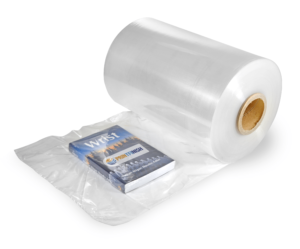In the dynamic world of packaging, staying ahead requires constant innovation. One such area of continuous evolution is PET Shrink Film technology. This unassuming material has undergone remarkable transformations in recent times, paving the way for more efficient, sustainable, and versatile packaging solutions. In this blog post, we shine a spotlight on the recent developments in PET Shrink Film technology, exploring the cutting-edge advancements that are shaping the future of packaging.
I. The Evolution of PET Shrink Film Technology:
A. Origins and Early Applications:
PET Shrink Film technology traces its roots back to the mid-20th century when the demand for more efficient packaging solutions began to rise. The initial applications were limited, primarily focused on providing tamper-evident seals for bottles in the beverage industry. As technology advanced, so did the capabilities of PET Shrink Film.
B. Enhanced Shrink Properties:
Recent developments have significantly improved the shrink properties of PET Shrink Film. Innovations in the manufacturing process, including molecular engineering and extrusion technologies, have resulted in films with enhanced shrink ratios. This means a tighter and more secure fit around products, providing better protection and presentation.
II. Advanced Characteristics of Modern PET Shrink Film:
A. High Clarity and Printability:
Modern PET Shrink Film boasts unparalleled clarity, allowing consumers to see the packaged product clearly. This characteristic not only enhances the visual appeal of the product on the retail shelf but also provides an excellent surface for printing. Brands can leverage this feature to create vibrant, eye-catching designs and convey essential product information.
B. Sustainability Features:
In response to the growing emphasis on sustainability, recent developments in PET Shrink Film technology have focused on eco-friendly solutions. Manufacturers now offer recyclable PET Shrink Film, contributing to the reduction of plastic waste. Additionally, the lightweight nature of the film reduces the overall environmental impact associated with packaging.
C. Improved Sealing and Tamper-Evidence:
Advancements in sealing technologies have led to more robust and efficient seals. The tamper-evident properties of PET Shrink Film have been enhanced, providing consumers with a clear visual indicator of the product’s integrity. This is particularly crucial in industries where consumer trust and safety are paramount.
III. Applications Across Industries:
A. Food and Beverage:
The food and beverage industry has been a primary beneficiary of recent PET Shrink Film innovations. The film’s ability to conform tightly to various shapes and sizes makes it ideal for packaging a wide range of products, from fresh produce to bottled beverages. The improved seal and tamper-evident features contribute to the industry’s stringent quality and safety standards.
B. Consumer Goods:
In the consumer goods sector, where packaging plays a pivotal role in branding and marketing, PET Shrink Film has found diverse applications. Products ranging from electronics to cosmetics benefit from the film’s high clarity, printability, and protective properties. Recent developments have further expanded the possibilities for creative and visually appealing packaging designs.
C. Pharmaceuticals and Health Care:
The pharmaceutical industry demands packaging solutions that ensure product safety and compliance with regulatory standards. Recent advancements in PET Shrink Film technology have introduced features such as enhanced barrier properties, providing an additional layer of protection for pharmaceutical products. The film’s ability to accommodate intricate packaging requirements makes it a valuable asset in this sector.
IV. Innovations in Manufacturing Processes:
A. Molecular Engineering:
Recent developments in molecular engineering have played a crucial role in enhancing the properties of PET Shrink Film. Manufacturers now have the capability to tailor the molecular structure of the film, resulting in improved shrink performance, durability, and overall packaging efficiency.
B. Extrusion Technologies:
Innovations in extrusion technologies have contributed to the production of PET Shrink Film with consistent thickness and superior optical properties. These advancements ensure that the film maintains its clarity and performance, meeting the demanding requirements of various industries.
V. Sustainable Practices in PET Shrink Film Production:
A. Recyclable Materials:
One of the notable shifts in recent PET Shrink Film technology is the use of recyclable materials. Manufacturers are increasingly adopting PET resins that are fully recyclable, contributing to a more circular economy and reducing the environmental impact of packaging materials.
B. Reduced Energy Consumption:
Efforts to make PET Shrink Film production more sustainable extend to the manufacturing process itself. Innovations in energy-efficient equipment and processes have resulted in reduced energy consumption during film production, aligning with the broader industry push towards sustainable practices.
VI. Challenges and Solutions:
A. Heat Application Efficiency:
While heat application is fundamental to the functionality of PET Shrink Film, ensuring its efficiency and uniformity can be a challenge. Recent technological developments in heat tunnels and application systems address these challenges, providing more precise control over the shrinking process.
B. Compatibility with Sensitive Products:
Certain products, especially those sensitive to heat, may pose challenges when using PET Shrink Films. To address this, manufacturers are developing specialized formulations and processes to ensure the compatibility of the film with a broader range of products, expanding its applicability across diverse industries.
VII. Future Trends and Emerging Technologies:
A. Smart Packaging Integration:
The integration of smart packaging technologies is an exciting frontier for PET Shrink Film. Incorporating features such as QR codes, RFID tags, or sensors can provide real-time information about the product’s status, enhancing traceability, and improving the overall consumer experience.
B. Biodegradable PET Shrink Film:
As the demand for eco-friendly packaging solutions continues to rise, the development of biodegradable PET Shrink Film is gaining traction. Manufacturers are exploring formulations that maintain the film’s functionality while allowing for environmentally friendly disposal.
VIII. Conclusion:
In conclusion, the recent developments in PET Shrink Film technology underscore its adaptability and responsiveness to the evolving needs of the packaging industry. From enhanced clarity and printability to sustainable practices and innovative manufacturing processes, PET Shrink Film continues to play a pivotal role in shaping the future of packaging. As we look ahead, the integration of smart technologies and the pursuit of biodegradable solutions signal a promising era for PET Shrink Film, reaffirming its status as a versatile and indispensable packaging material.






